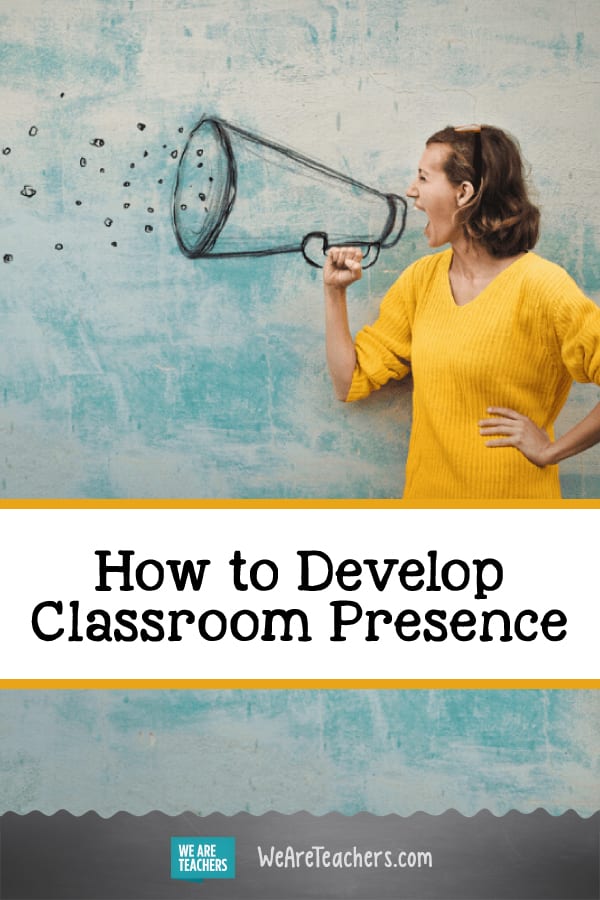“How do you develop your teacher voice?” This was the question a newbie high school teacher, who describes herself as naturally soft spoken and polite, asked recently in our WeAreTeachers HELPLINE group on Facebook. “Administrators have told me my voice is too weak,” she says, “and that it prevents credibility and has led to my classroom management struggles.”
Her question brings up a couple of different points: Is her voice not being heard? Or is it more about classroom presence? The short answer is both. Many teachers responded and confirmed that having a strong and authoritative voice goes a long way toward managing a classroom. But the “teacher voice” to which our soft-spoken friend referred is about so much more—tone, intention, body language, confidence, and more. And all of those things add up to classroom presence.
Although it often takes years to develop, here are some of the lessons our HELPLINE teachers have learned along the way.
It’s not about yelling.
“Yelling is always loud and is an act of desperation to get others to listen to you,” says C.W. You don’t need to yell at kids like a drill sergeant or resort to a shrill tone. In fact, it doesn’t take long for kids to learn to tune out teachers who are known as yellers.
What it’s really all about is confidence. “If you know you are in charge and you tell yourself the students will listen to you, you will speak with the confidence that makes others listen.” C.S. puts it this way: “Give off the vibe that you mean business,” she says. H.B. agrees, “Own every inch of your classroom. Fill it up with your presence.”
[contextly_auto_sidebar]
It’s not just what you say, it’s how you say it.
Many teachers pointed out that teacher voice is more about the words and tone you choose rather than the volume. They advised choosing your words intentionally—at times the fewer the better. Vary your tempo and speak clearly and directly. and being bold and powerful with your delivery.
“Avoid putting the word ‘okay’ at the end of a statement,” says L.M. “Make sure the inflection of your voice goes down when you give instructions, never up as if you’re asking a question,” adds H.B. And J.S. shared the oldest secret in the book: “I pause for drama, sometimes in the middle of a sentence or word.”
Your body language speaks volumes.
A.C. uses her posture to convey that she is in charge. “I suggest a good power pose,” she says. “Direct eye contact, standing tall, with chin up, and shoulders back.” H.B. shares a valuable tip she learned from a TED Talk: making herself appear bigger by using body language. “Imagine the way a bear stands on its hind legs,” she says, “or an animal fluffs up its fur.” For more impactful advice on developing your classroom presence, check out these 6 Brilliant TED Talks to Improve Your Speaking Voice
Use proximity to your advantage.
Talking across the room rarely works, especially for students who are well versed in avoiding eye contact and “not hearing” the directions. Walk over and stand right next to the talker/disrupter and speak directly to them in a quiet voice. You’ll get the message across that when you are speaking to the class, they need to listen like everyone else.
Refuse to talk over students.
So many new teachers allow students to drown them out with their chit chat. It’s essential to pause until you have the class’ full attention. Establish signals that let your students know that it’s time to direct their full attention to you. It may take a while at first, but it’s well worth the wait, if only to save yourself from repeating yourself a hundred times. Consider a system of rewards and consequences for listening the first time.
Never underestimate the power of “The Look.”
Twin sibling to the Teacher Voice is the Teacher Look. Dead serious, eyebrows raised, pausing for dramatic effect. The look, according to L.H., that says “just try me and see what happens.” “Once you master The Look,” says A.R. you will have established your domain.”
Learn how to project your voice safely.
There is a science behind building a powerful voice. C.M. explains the basic process, “Push air from your diaphragm and not your throat. It will help you project without killing your throat.” Many teachers suggested investing in vocal training or seeking help from your school’s drama, speech, or choir teacher. Teacher RW highly recommends the book Change Your Voice, Change Your Life by Dr. Morton Cooper. And for more advice, check out 8 Tips for Saving Your Teacher Voice.
If all else fails …
Many teachers sang the praises of using a personal voice amplifier or microphone headset. “It takes the physical effort out of raising your voice and just gets the students’ attention more quickly,” offers T.W. Here’s one inexpensive model recommended by teacher L.S.
How did you find your teacher voice in the classroom? Come share in our WeAreTeachers HELPLINE group on Facebook.
For more great advice check out Yelling Doesn’t Work With Kids, So What Should You Do Instead?


